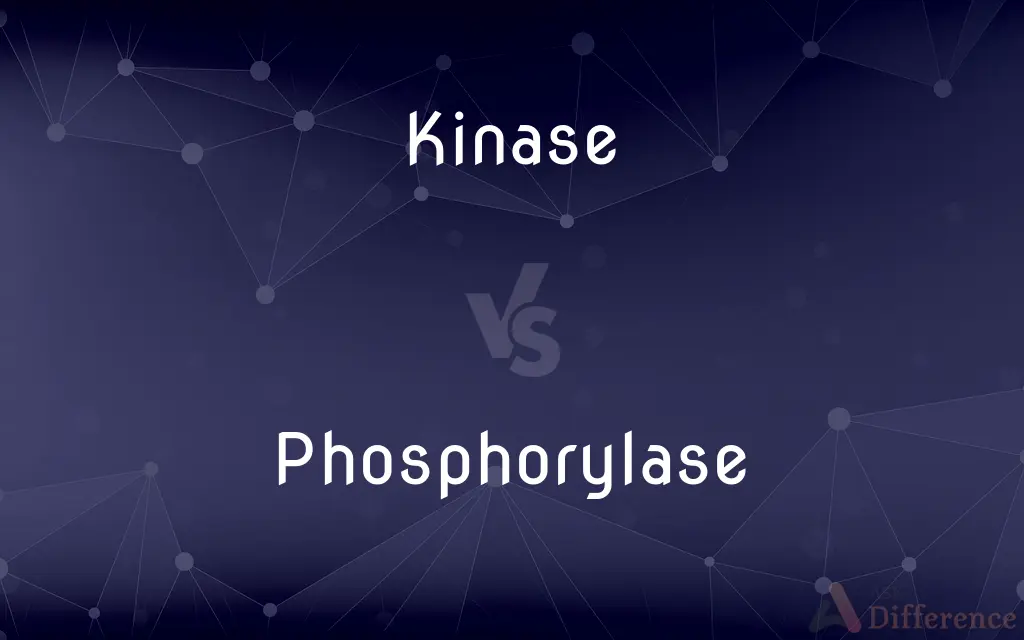Kinase vs. Phosphorylase — What's the Difference?
By Maham Liaqat & Urooj Arif — Updated on March 20, 2024
Kinase and phosphorylase are enzymes involved in cellular processes, but they differ in function and mechanism. Kinase transfers a phosphate group from a high-energy molecule, while phosphorylase adds a phosphate group to substrate without using ATP.

Difference Between Kinase and Phosphorylase
Table of Contents
ADVERTISEMENT
Key Differences
Kinase is involved in signaling pathways and metabolic processes, catalyzing the transfer of a phosphate group to proteins, lipids, and other molecules, thus modifying their activity, reactivity, or location. Phosphorylase, on the other hand, plays a key role in breaking down complex molecules like glycogen into simpler ones like glucose-1-phosphate, facilitating energy release.
The action of kinase is crucial for activating or deactivating enzymes and receptors, thereby playing a pivotal role in regulating cellular activities such as cell division, growth, and metabolism. Phosphorylase, conversely, is primarily involved in catabolic processes, breaking down molecules to release energy stored in chemical bonds.
Kinases are highly specific and can act on a wide variety of substrates, making them versatile in their roles in cellular functions. Phosphorylases, while also specific, are generally involved in fewer pathways, with their action mostly confined to the metabolism of carbohydrates and nucleotides.
Understanding the functions of kinase and phosphorylase is essential in biochemistry and molecular biology, as they are involved in fundamental processes within the cell. Their study is crucial for developing treatments for diseases where these enzymes' regulation is disrupted, such as in certain cancers and metabolic disorders.
Comparison Chart
Function
Transfers a phosphate group from ATP to a substrate.
Adds a phosphate group to a substrate without using ATP.
ADVERTISEMENT
Role in Cells
Involved in signaling pathways and regulating cellular activities.
Primarily involved in the breakdown of complex molecules.
Mechanism
Uses ATP as a phosphate donor.
Uses inorganic phosphate as a donor.
Substrate
Proteins, lipids, and other molecules.
Mainly carbohydrates and nucleotides.
Process
Can activate or deactivate enzymes and receptors.
Facilitates energy release from molecules like glycogen.
Compare with Definitions
Kinase
Transfers phosphate from ATP.
The kinase catalyzed the phosphorylation of the protein, altering its function.
Phosphorylase
Adds phosphate without ATP.
The phosphorylase added an inorganic phosphate to the substrate, breaking it down.
Kinase
Key in signaling and metabolism.
Kinases are integral to the pathways that control cell division.
Phosphorylase
Involved in energy release.
Phosphorylases are crucial in the catabolic pathways that release energy.
Kinase
Highly specific to substrates.
Each kinase is tailored to target specific proteins or lipids.
Phosphorylase
Plays a role in metabolism.
Phosphorylases are key in the metabolic processes that provide energy to cells.
Kinase
Activates or deactivates molecules.
The enzyme's action can turn enzymes on or off, affecting cellular processes.
Phosphorylase
Specific to certain pathways.
Glycogen phosphorylase breaks down glycogen to glucose-1-phosphate.
Kinase
Involved in diverse cellular functions.
Kinases play roles in growth, cell division, and metabolism.
Phosphorylase
Catalyzes breakdown of molecules.
The enzyme facilitates the breakdown of complex carbohydrates.
Kinase
In biochemistry, a kinase is an enzyme that catalyzes the transfer of phosphate groups from high-energy, phosphate-donating molecules to specific substrates. This process is known as phosphorylation, where the substrate gains a phosphate group and the high-energy ATP molecule donates a phosphate group.
Phosphorylase
In biochemistry, phosphorylases are enzymes that catalyze the addition of a phosphate group from an inorganic phosphate (phosphate+hydrogen) to an acceptor. A-B + P ⇌ A + P-BThey include allosteric enzymes that catalyze the production of glucose-1-phosphate from a glucan such as glycogen, starch or maltodextrin.
Kinase
Any of various enzymes that catalyze the transfer of a phosphate group from a donor, such as ADP or ATP, to an acceptor protein. Kinases regulate many essential cellular processes.
Phosphorylase
Any of a class of enzymes that catalyze the attachment of a phosphate group to another molecule.
Kinase
Any of a group of enzymes that transfer phosphate groups from high-energy donor molecules, such as ATP, to specific target molecules (substrates), in a process termed phosphorylation.
Phosphorylase
(enzyme) Any enzyme that catalyzes the production of glucose phosphate from glycogen and inorganic phosphate
Kinase
One of a class of enzymes that catalyze transfer of a phosphate group from ATP to another molecule; it is a type of phosphorylase.
Kinase
An enzyme that catalyzes the conversion of a proenzyme to an active enzyme
Common Curiosities
How are kinases and phosphorylases involved in disease processes?
Dysregulation of kinase and phosphorylase activities can lead to diseases, including certain cancers and metabolic disorders, making them targets for therapeutic intervention.
Can phosphorylase activate molecules like kinase?
Phosphorylase is primarily involved in breaking down molecules for energy release and does not typically activate or deactivate molecules like kinase.
What roles do kinases play in cellular activities?
Kinases are involved in numerous cellular activities, including signaling pathways, cell division, growth, and metabolism, by activating or deactivating enzymes and receptors.
What is the role of phosphorylase in glycogen metabolism?
Phosphorylase plays a crucial role in glycogen metabolism by catalyzing the breakdown of glycogen into glucose-1-phosphate, thereby mobilizing stored energy.
How is kinase activity regulated in the cell?
Kinase activity is regulated through various mechanisms including phosphorylation, interaction with regulatory proteins, and changes in gene expression.
What is the main function of a kinase?
A kinase's main function is to transfer a phosphate group from ATP to a substrate, modulating the activity, reactivity, or location of the substrate.
What are the implications of kinase inhibitors in medicine?
Kinase inhibitors are important in medicine for treating diseases such as cancer, where they can inhibit the activity of specific kinases involved in tumor growth and survival.
Can phosphorylase activity be influenced by hormonal signals?
Yes, phosphorylase activity can be influenced by hormonal signals such as adrenaline and glucagon, which activate phosphorylase kinase that, in turn, activates glycogen phosphorylase.
How does phosphorylase differ from kinase in terms of phosphate source?
Phosphorylase adds a phosphate group to a substrate without using ATP, often utilizing inorganic phosphate, unlike kinase, which uses ATP as a phosphate source.
Can kinases phosphorylate any type of molecule?
Kinases primarily phosphorylate proteins, lipids, and some other molecules, but they are highly specific in their action and do not target every type of molecule.
Are there diseases associated with phosphorylase deficiency?
Yes, diseases like McArdle's disease are associated with a deficiency in muscle glycogen phosphorylase, affecting muscle function and energy release.
What is the significance of reversible phosphorylation in cellular regulation?
Reversible phosphorylation, mediated by kinases and phosphatases, is a critical mechanism for cellular regulation, allowing rapid and reversible changes in protein activity and function.
How does the specificity of a kinase affect its role in signaling pathways?
The specificity of a kinase for its substrates ensures precise signaling pathways, as each kinase can trigger specific cellular responses by targeting particular proteins or lipids.
How do mutations in kinase and phosphorylase genes impact human health?
Mutations in kinase and phosphorylase genes can lead to altered enzyme activity or expression, contributing to the development of various diseases, including metabolic disorders and cancers.
How do kinases and phosphorylases interact in cellular pathways?
Kinases and phosphorylases can interact in cellular pathways where the activation or inhibition of one enzyme by phosphorylation can impact the activity of the other, coordinating cellular processes.
Share Your Discovery

Previous Comparison
Norse vs. Viking
Next Comparison
Dorsal vs. VentralAuthor Spotlight
Written by
Maham LiaqatCo-written by
Urooj ArifUrooj is a skilled content writer at Ask Difference, known for her exceptional ability to simplify complex topics into engaging and informative content. With a passion for research and a flair for clear, concise writing, she consistently delivers articles that resonate with our diverse audience.














































